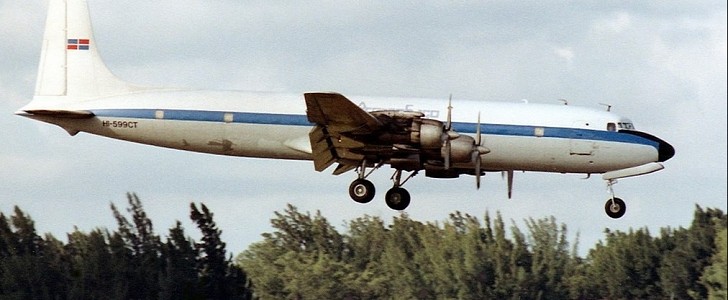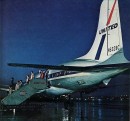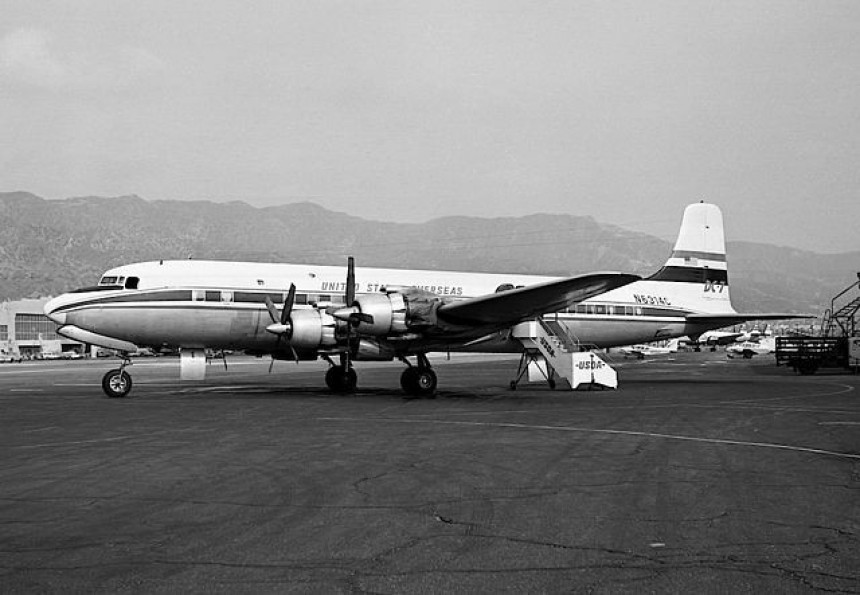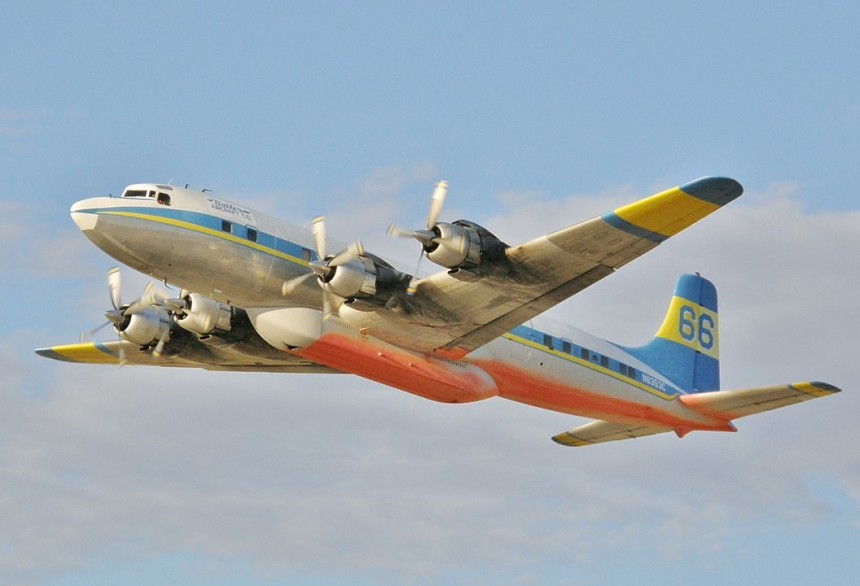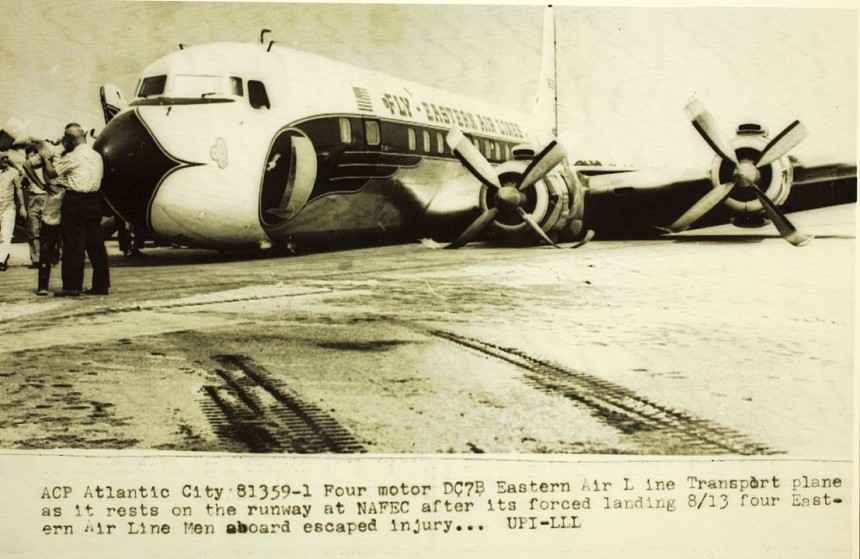Hundreds of different passenger airliners have gone into service in the last century-plus. Only a handful went on to be remembered in any substantial way. But the Douglas DC-7 sure did, if not always for the right reasons. If you're aware of it, it's likely because it's the airplane one of Major League Baseball's most iconic stars lost his life inside.
But the tragic death of Roberto Clemente was only the most newsworthy story in the history of the DC-7, an airplane decreed by the powers that be must close out the era of piston-engine airliners for Douglas. Giving way to turbofan jet power in the process. Let's take a closer look at the details. Of course, the DC-7 is forever linked to its predecessors on which it was based, the DC-4 and DC-6.
Used by airlines and Air Forces around the world, the quad-engine DC-4 and DC-6 were derived from a line of Douglass Aircraft Company airliners that opened up commercial travel to the masses like never before, beginning with the DC-3/C-47, perhaps the world's most important airplane. Between the early 1940s and late 1950s, if there was an airliner flying overhead in the sky, chances were good it was one built by Douglas.
Unlike its predecessors, the DC-7 didn't enjoy the luxury of next to no competition outside of Boeing. Its set of four Wright R-3350 Duplex-Cyclone eighteen-cylinder radial engines cranking 3,400 hp each and a top speed of just over 400 mph looked great on paper at the time. But it was soon to be dwarfed in performance by jet airliners, some of which came from Douglas themselves. By the time of its operational introduction, the De Haviland Comet jetliner was already flying.
But in the meantime, global airliners busied themselves placing orders for what was supposed to be the next in a series of dependable, iconic airplanes. Initial impressions were overall rather positive. With fuel tanks capable of carrying 220 US gallons (883 liters) of fuel in each wing, a DC-7 could make the run between Johannesburg, South Africa, and London with just a single connecting flight. Even in 2022, that's somewhat impressive.
To top it all off, the DC-7 was almost two hours faster than the equivalent Boeing piston airliner, the 377 Super Stratocruiser, from London or Paris to any of New York City's three major airports. This was the case even with the Super Stratocruiser's Pratt & Whitney R-4360 Wasp Major engines being a whopping ten cylinders larger. In services with major airlines like Delta, American Airlines, KLM, Pan American, Mexicana, and British Overseas, the DC-7 managed to build 338 airframes between 1953 and 1958.
As if by some by possession of the most ruthless of evil spirits, a slew of incidents began to befall the DC-7 fleet almost as soon as production ended. A handful of accidents in 1956 and 57 could be written off as pilot errors. But a March 1958 incident in which a Braniff Airlines flight's engine caught fire, resulting in the plane smashing into the ground after takeoff, was an ominous harbinger of the troubles to come.
It was one of the first in a series of 82 separate incidents involving DC-7s that claimed the lives of at least 714 people. Compared to the 13 hull losses and 139 fatalities attributed to the Boeing Stratocruiser mentioned above, suddenly, that extra hour and 45 minutes of flying time don't sound like much of a sacrifice. In the days before flying was the safest way to travel, such accidents were a part of the territory. But even by the standards of its day, the DC-7's accident history was dubious at best and abysmal at worst.
But like its brother in infamy, the Boeing 737 Max, it only takes one or two truly newsworthy air disasters to obliterate a commercial airliner's reputation. For the DC-7, that came on New Year's Eve, 1972, at Isla Verde International Airport, in San Juan, Puerto Rico. On board that particular DC-7CF was the two-time Major League Baseball World Series champion and 15-time All-Star for the Pittsburgh Pirates, Roberto Clemente.
Fresh off his landmark 3,000th career base hit off of New York Mets pitcher John Matlack just a few months before, Clemente had chartered a flight from his native Puerto Rico to Managua, Nicaragua. Initially, the journey was taken to coach the Puerto Rican national team in that year's Baseball World Cup. This flight turned into an impromptu U.N.-style relief mission when the region suffered a 6.3-magnitude earthquake the week before the flight.
Laden with food, medical supplies, and clean clothes, Clemente himself personally supervised the cargo loaded onto the plane. Supplies he himself paid for in full. Little did he know, that little devil known as engine failure would rear its head when the plane took off. It crashed into the Caribbean Sea after a failed attempt at a water landing, taking the life of all on board.
In an unprecedented move, the Baseball Writers' Association of America agreed by a 92.7-percent approval rating in a snap election to induct Clemente into the National Baseball Hall of Fame posthumously. Meanwhile, native Puerto Ricans who hero-worshipped Clemente damned the DC-7 and its maintenance team for allowing the plane to take off in such a sorry state of repair.
Today, the wreck site is listed on the US National Register of Historic Places, being added in 2022. Whether the accident had anything to do with the integrity of Douglas' design, it became a dark stain on an otherwise white proverbial T-shirt that the DC-7 could never truly clean away. How can we see this? Well, the DC-7 is currently the only one of the classic Douglas airliners that isn't still flying to this very day. Knowing the omen beneath its wings, it's totally understandable.
Check back soon for more airplane profiles and so much more here on autoevolution.
Used by airlines and Air Forces around the world, the quad-engine DC-4 and DC-6 were derived from a line of Douglass Aircraft Company airliners that opened up commercial travel to the masses like never before, beginning with the DC-3/C-47, perhaps the world's most important airplane. Between the early 1940s and late 1950s, if there was an airliner flying overhead in the sky, chances were good it was one built by Douglas.
Unlike its predecessors, the DC-7 didn't enjoy the luxury of next to no competition outside of Boeing. Its set of four Wright R-3350 Duplex-Cyclone eighteen-cylinder radial engines cranking 3,400 hp each and a top speed of just over 400 mph looked great on paper at the time. But it was soon to be dwarfed in performance by jet airliners, some of which came from Douglas themselves. By the time of its operational introduction, the De Haviland Comet jetliner was already flying.
But in the meantime, global airliners busied themselves placing orders for what was supposed to be the next in a series of dependable, iconic airplanes. Initial impressions were overall rather positive. With fuel tanks capable of carrying 220 US gallons (883 liters) of fuel in each wing, a DC-7 could make the run between Johannesburg, South Africa, and London with just a single connecting flight. Even in 2022, that's somewhat impressive.
As if by some by possession of the most ruthless of evil spirits, a slew of incidents began to befall the DC-7 fleet almost as soon as production ended. A handful of accidents in 1956 and 57 could be written off as pilot errors. But a March 1958 incident in which a Braniff Airlines flight's engine caught fire, resulting in the plane smashing into the ground after takeoff, was an ominous harbinger of the troubles to come.
It was one of the first in a series of 82 separate incidents involving DC-7s that claimed the lives of at least 714 people. Compared to the 13 hull losses and 139 fatalities attributed to the Boeing Stratocruiser mentioned above, suddenly, that extra hour and 45 minutes of flying time don't sound like much of a sacrifice. In the days before flying was the safest way to travel, such accidents were a part of the territory. But even by the standards of its day, the DC-7's accident history was dubious at best and abysmal at worst.
But like its brother in infamy, the Boeing 737 Max, it only takes one or two truly newsworthy air disasters to obliterate a commercial airliner's reputation. For the DC-7, that came on New Year's Eve, 1972, at Isla Verde International Airport, in San Juan, Puerto Rico. On board that particular DC-7CF was the two-time Major League Baseball World Series champion and 15-time All-Star for the Pittsburgh Pirates, Roberto Clemente.
Laden with food, medical supplies, and clean clothes, Clemente himself personally supervised the cargo loaded onto the plane. Supplies he himself paid for in full. Little did he know, that little devil known as engine failure would rear its head when the plane took off. It crashed into the Caribbean Sea after a failed attempt at a water landing, taking the life of all on board.
In an unprecedented move, the Baseball Writers' Association of America agreed by a 92.7-percent approval rating in a snap election to induct Clemente into the National Baseball Hall of Fame posthumously. Meanwhile, native Puerto Ricans who hero-worshipped Clemente damned the DC-7 and its maintenance team for allowing the plane to take off in such a sorry state of repair.
Today, the wreck site is listed on the US National Register of Historic Places, being added in 2022. Whether the accident had anything to do with the integrity of Douglas' design, it became a dark stain on an otherwise white proverbial T-shirt that the DC-7 could never truly clean away. How can we see this? Well, the DC-7 is currently the only one of the classic Douglas airliners that isn't still flying to this very day. Knowing the omen beneath its wings, it's totally understandable.
